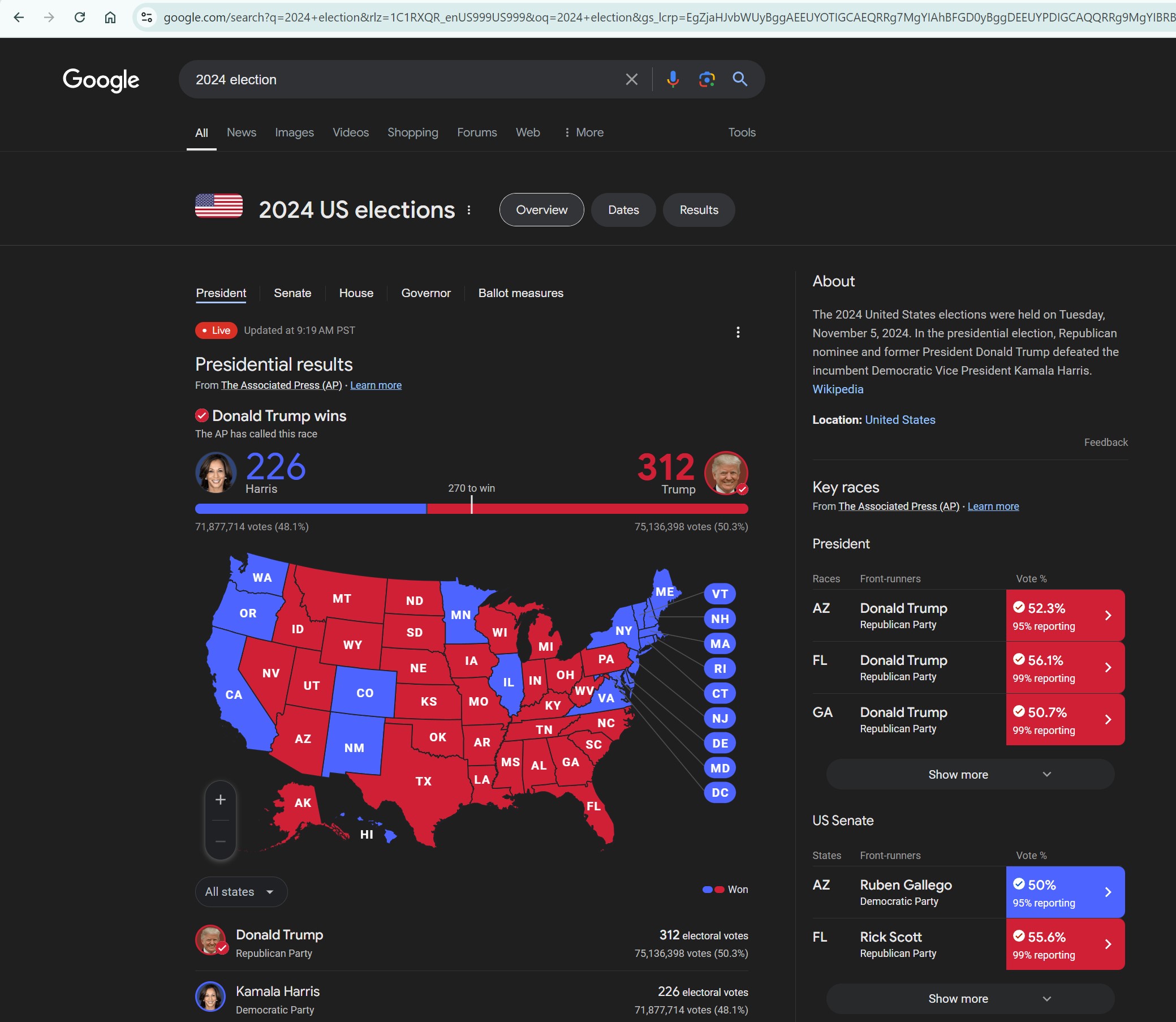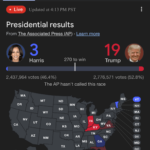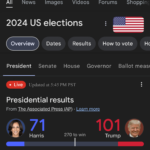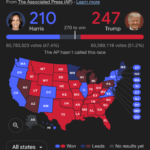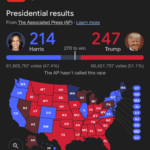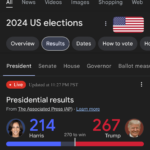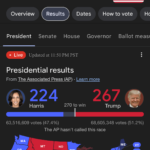Donald Trump elected as the next President of the United States
In election victory, Trump’s gains went beyond the battlegrounds
Trump’s gains in reliably blue states like NY outpaced those made in battlegrounds that won him the election
President-elect Trump flipped six highly competitive states in his election victory last week. But his gains with voters were not limited to the battlegrounds.
Trump improved his vote share across the country, starting with conservative areas but extending into deeply Democratic states.
It is a critical part of the story of this election: on
Trump gained in the battlegrounds and beyond, including traditionally Democratic areas
Trump gained in all seven of the battleground states. He gained 1.8 points in Michigan and Pennsylvania, 1.4 points in Georgia, just over a point in North Carolina, and under a point in Wisconsin.
(Trump’s largest gains are currently in Nevada and Arizona, two of ten states where there is significant vote left to count.)

But Trump’s best performances relative to 2020 were in reliably Democratic states. These states voted for Democrats, but by narrower margins than before.
His strongest improvement was in New York, where the former and future president gained 6.4 points.
His county-level gains were spread across the state, but notably included an improvement in all five of the New York City boroughs (where, again, there are some votes left to be counted).
He also posted a 5-point improvement in neighboring New Jersey, enough to reduce the margin of his loss to just 5.5 points. That is the best performance for a Republican candidate in more than three decades.
Look for New Jersey and Virginia (Trump +2.4 since 2020) to become a focal point in future elections, beginning with next year’s gubernatorial races.
Trump also took more vote share in Illinois (Trump +4.2 since 2020); another Democratic state with a highly populated urban area.

President-elect Trump made vast improvements over his 2020 numbers, particularly in urban areas and, most surprisingly, in reliably blue states. (Chip Somodevilla/Getty Images)
And as some pre-election polls predicted, the president-elect brought home another five points worth of votes in Florida, where Democrats fought hard for a victory just two cycles ago.
Just as he improved in the battlegrounds and left-leaning states, he also put up strong gains in states like Texas, Tennessee, South Carolina and Idaho. Trump posted a 3-point improvement in all four of those conservative states, with smaller improvements in over a dozen more.
In fact, as of this writing, there isn’t a single state in the country where Trump turned in a weaker performance than he did four years ago.
Harris’ gains limited to a handful of disparate areas
But even in Utah, Trump also performed about a point better than he did in 2020. It’s third party candidates who saw the most erosion. (And there are many ballots left to count.)
To find positives for Harris, you have to search for a smattering of counties across the nation.

Suburban Atlanta was one of very few areas across the country where Vice President Harris improved on Democrats’ 2020 numbers. (iStock)
The Vice President did between 2-9 points better in a few counties in the Georgia metropolitan area, led by Henry, Rockdale and Douglas.
She also improved in some of the North Carolina counties most impacted by Hurricane Helene, particularly Democratic-leaning Buncombe, but also Henderson and Transylvania. She posted about a 4-point gain in each.
Kaufman County, in the Dallas suburbs, also bucked the national trend. That Texas county swung about 6 points towards Harris.
Harris posted a modest gain in Chaffee County, Colorado, otherwise known as the “Heart of the Rockies” (here, too, there are some outstanding ballots).
And there are signs that parts of Oregon and Washington could end up more Democratic than 2020 when counting is finished.
These are the exceptions to a clear rule: voters almost uniformly swung away from the Democrats this cycle.
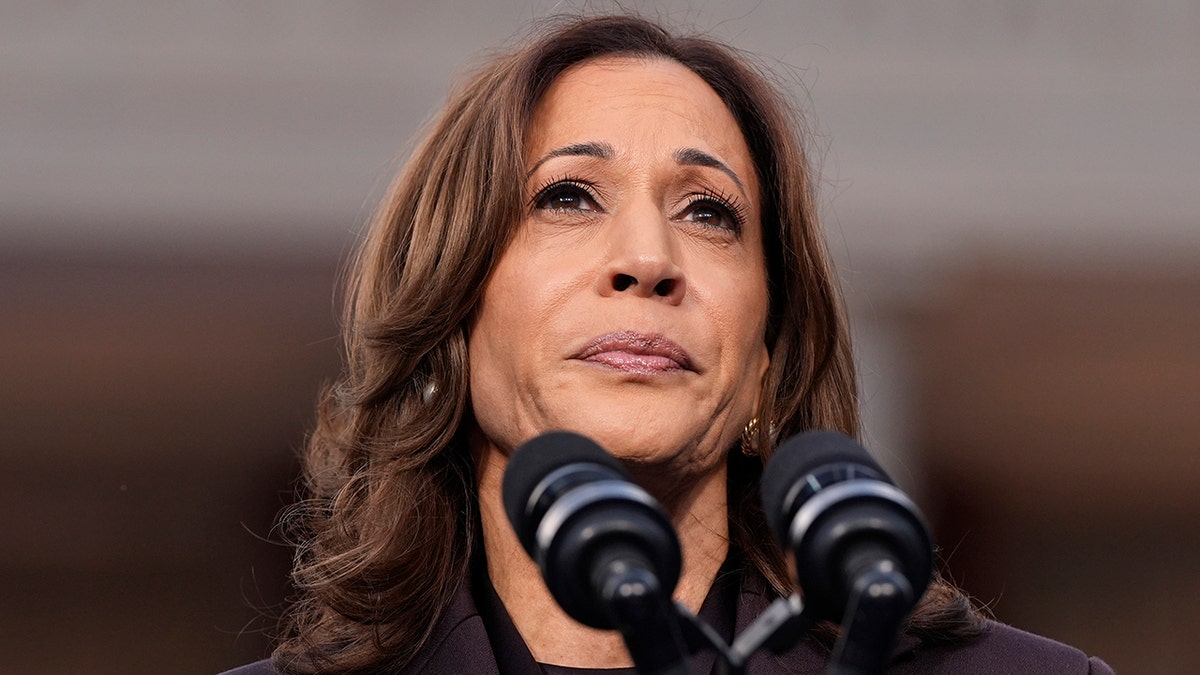
Vice President Harris’ candidacy saw a near-uniform swing away from Democrats by voters this cycle. (AP/Jacquelyn Martin)
Trump created a broader coalition and led on the top two issues
Trump’s victory was powered by his strength on the economy and immigration – two of voters’ top concerns. He was seen as a stronger leader than Harris in a time of turmoil, and voters remembered his presidency more fondly than their evaluations of the current administration. Trump ran up the score with his base while narrowing traditional Democratic advantages among Black, Hispanic, and young voters. source
The 2024 United States presidential election was the 60th quadrennial presidential election, held on Tuesday, November 5, 2024.[3] The Republican Party’s ticket—Donald Trump, who was the 45th president of the United States from 2017 to 2021, and JD Vance, the junior U.S. senator from Ohio—defeated the Democratic Party’s ticket—Kamala Harris, the incumbent U.S. vice president, and Tim Walz, the governor of Minnesota.[4][5] Trump and Vance are scheduled to be inaugurated as the 47th president and the 50th vice president on January 20, 2025, after their formal election by the Electoral College.[6][7]
The incumbent president, Joe Biden of the Democratic Party, initially ran for re-election with Harris as the party’s presumptive nominee,[8] facing little opposition;[9] however, what was broadly considered a poor debate performance in June 2024 intensified concerns about his age and health, and led to calls within his party for him to leave the race.[10] After initially declining to do so, Biden withdrew on July 21, becoming the first eligible incumbent president to withdraw since Lyndon B. Johnson in 1968.[11] Biden endorsed Vice President Kamala Harris,[12] who was voted the party’s nominee by the delegates on August 5, 2024. Harris selected Walz as her running mate.[13][14]
Trump, who lost the 2020 election to Biden, ran for re-election again, this time for a non-consecutive term.[15] He was nominated during the 2024 Republican National Convention along with his running mate, Vance, after winning the Republican primaries. The Trump campaign was noted for making many false and misleading statements, including the claim that the 2020 election was stolen from Trump,[16][17][18][19] engaging in anti-immigrant fearmongering,[a] and promoting conspiracy theories.[20][21] His speeches were widely described as marked by authoritarian and dehumanizing rhetoric toward his political opponents.[b] His campaign and populist political movement were characterized by several historians and former Trump administration officials as featuring parallels to fascism.[c]
In May 2024, Trump became the first U.S. president to be convicted of a crime after he was found guilty on multiple felony counts of falsifying business records related to hush money payments made to the pornographic actress Stormy Daniels.[22] He was previously found liable for sex abuse against E. Jean Carroll and for business fraud in New York. He was also twice impeached, once in 2019 and again in 2021. He remains under multiple indictments for his attempts to overturn the 2020 election, his role in the January 6 attack on the Capitol, and his election racketeering prosecution in Georgia. Trump survived two assassination attempts in the four months before the election: the first at a rally in Butler, Pennsylvania, and the second at Trump International Golf Club in West Palm Beach, Florida.[23][24]
According to polls, the most important issues for voters were the economy,[25] healthcare,[26] democracy,[27][28] foreign policy (notably U.S. support for Israel and for Ukraine),[29] violent crime,[30] immigration,[31][32] gun policy,[30] abortion,[33][34][35] racial and ethnic inequality,[30] and climate change.[30][36][37] Education and LGBTQ rights were also prominent issues in the campaign.[38][39] Polled voters consistently cited the economy as being the single most important issue in the election.[25][30] According to Pew Research, immigration was the second-most important issue to Trump supporters but the least-important issue to Harris supporters.[30]
Trump achieved a decisive victory, sweeping every swing state in addition to holding on to all of the states that he won in 2020.[40][41] Trump won 312 electoral votes, the best performance for a Republican presidential ticket since George H. W. Bush in 1988, and also won the national popular vote, making him the first Republican to do so since George W. Bush in 2004.[42] Trump significantly improved his vote share among almost all demographics nationwide, particularly among Hispanic voters, in a working class coalition described as the most racially diverse for a Republican presidential candidate in decades.[43][44][45] Having previously won in 2016, Trump became the second president elected to a non-consecutive second term, 132 years after Grover Cleveland defeated Benjamin Harrison in 1892; this was also the first election since 1892 in which the incumbent White House party was defeated in three consecutive elections.[46] Trump, aged 78, is also the oldest person ever to be elected U.S. president, and Vance, aged 40, is the first millennial vice president.[47][48] Harris’ result of 226 electoral votes was the worst performance for a Democratic presidential ticket since Michael Dukakis in 1988. source

